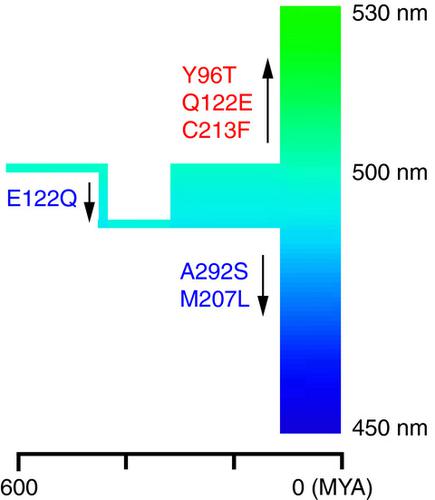当前位置:
X-MOL 学术
›
FEBS Open Bio
›
论文详情
Our official English website, www.x-mol.net, welcomes your feedback! (Note: you will need to create a separate account there.)
Origin and adaptation of green-sensitive (RH2) pigments in vertebrates.
FEBS Open Bio ( IF 2.6 ) Pub Date : 2020-04-11 , DOI: 10.1002/2211-5463.12843 Shozo Yokoyama 1, 2 , Huiyong Jia 1
FEBS Open Bio ( IF 2.6 ) Pub Date : 2020-04-11 , DOI: 10.1002/2211-5463.12843 Shozo Yokoyama 1, 2 , Huiyong Jia 1
Affiliation

|
One of the critical times for the survival of animals is twilight where the most abundant visible lights are between 400 and 550 nanometres (nm). Green‐sensitive RH2 pigments help nonmammalian vertebrate species to better discriminate wavelengths in this blue‐green region. Here, evaluation of the wavelengths of maximal absorption (λmaxs) of genetically engineered RH2 pigments representing 13 critical stages of vertebrate evolution revealed that the RH2 pigment of the most recent common ancestor of vertebrates had a λmax of 503 nm, while the 12 ancestral pigments exhibited an expanded range in λmaxs between 474 and 524 nm, and present‐day RH2 pigments have further expanded the range to ~ 450–530 nm. During vertebrate evolution, eight out of the 16 significant λmax shifts (or |Δλmax| ≥ 10 nm) of RH2 pigments identified were fully explained by the repeated mutations E122Q (twice), Q122E (thrice) and M207L (twice), and A292S (once). Our data indicated that the highly variable λmaxs of teleost RH2 pigments arose from gene duplications followed by accelerated amino acid substitution.
中文翻译:

绿敏感(RH2)颜料在脊椎动物中的起源和适应性。
动物生存的关键时期之一是暮光,最丰富的可见光在400至550纳米(nm)之间。对绿色敏感的RH2颜料可帮助非哺乳动物脊椎动物更好地区分该蓝绿色区域的波长。在这里,对代表脊椎动物进化的13个关键阶段的基因工程RH2颜料的最大吸收波长(λmax s)的评估显示,最近的脊椎动物共同祖先的RH2颜料的λmax为503 nm,而12个祖颜料在λ显示范围扩大最大波长介于474至524 nm之间,而如今的RH2颜料的范围进一步扩大至〜450–530 nm。在脊椎动物进化,八段16显著λ的最大位移(或|Δλ最大值|≥10nm)的识别是通过重复的突变E122Q(两次),Q122E(三次)和M207L(两次)充分解释RH2的颜料,并A292S(一次)。我们的数据表明,硬骨鱼RH2颜料的λmax s高度可变是由基因复制引起的,随后是加速的氨基酸取代。
更新日期:2020-04-11
中文翻译:

绿敏感(RH2)颜料在脊椎动物中的起源和适应性。
动物生存的关键时期之一是暮光,最丰富的可见光在400至550纳米(nm)之间。对绿色敏感的RH2颜料可帮助非哺乳动物脊椎动物更好地区分该蓝绿色区域的波长。在这里,对代表脊椎动物进化的13个关键阶段的基因工程RH2颜料的最大吸收波长(λmax s)的评估显示,最近的脊椎动物共同祖先的RH2颜料的λmax为503 nm,而12个祖颜料在λ显示范围扩大最大波长介于474至524 nm之间,而如今的RH2颜料的范围进一步扩大至〜450–530 nm。在脊椎动物进化,八段16显著λ的最大位移(或|Δλ最大值|≥10nm)的识别是通过重复的突变E122Q(两次),Q122E(三次)和M207L(两次)充分解释RH2的颜料,并A292S(一次)。我们的数据表明,硬骨鱼RH2颜料的λmax s高度可变是由基因复制引起的,随后是加速的氨基酸取代。



























 京公网安备 11010802027423号
京公网安备 11010802027423号